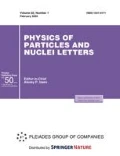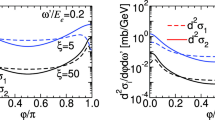Abstract
This work presents the GEANT4 simulation of the experimental setup for studying the Compton scattering of annihilation photons and compares the simulation results with the experimental data. Two 511 keV photons are born in electron-positron annihilation at rest and have mutually orthogonal polarization which is measured by the system of Compton polarimeters. Each polarimeter consists of scatterer of initial annihilation photons and NaI(Tl) detectors of scattered at 90° photons. Additionally, an intermediate scatterer of GAGG scintillator is used to produce the tagged decoherent photons. Different cases of two-photon quantum states have been simulated. In the first case, the setup response to Compton scattering of entangled photons with mutually perpendicular polarization was studied. In the second case similar study was done for decoherent photons that are produced if one of the initial photons interacts in intermediate scatterer. Distinctions in Compton scattering for these two cases have been obtained and compared to the experimental results. Energy spectra in NaI(Tl) detectors and angular distributions of scattered photons are presented for both entangled and decoherent cases.
Similar content being viewed by others
INTRODUCTION
Electron-positron annihilation at rest produces a pair of 511 keV gammas with opposite momenta. According to the quantum theory, such photons have mutually perpendicular polarization directions, while each of the photons has no definite polarization state. Since the Compton scattering of photons depends on the polarization, the distributions of scattered photons would reflect the polarization state. Experimental studies of annihilation photons are based on the theoretical results [1] that predict strong angular correlations of the scattered photons in case of entangled two-photon state. Most of the experiments were performed about 50 yr ago and observed the angular correlations of scattered photons in good agreement with the theoretical predictions. These correlations have been perceived as an experimental proof of the two-photons entanglement [2]. At the same time, the Compton scattering of annihilation photons in decoherent (mixed) states was not studied at all.
Recent theoretical works highlighted an unsatisfactory situation in study of annihilation photons. Thus, in [3] authors applied the open quantum formalism to Compton scattering and found that the cross section is identical for both entangled and mixed (separable) states. Respectively, authors assert that the entanglement of the two-photon state was not proven experimentally at all. This statement was strongly refuted in [4], where the matrix representation of Klein–Nishina formula for Compton scattering of photons was used and the calculated cross section is fundamentally different for the entangled and mixed states.
The experimental tests are requested to resolve the theoretical puzzle. First attempt to measure the Compton scattering of annihilation photons in separable state was made in [5]. Here, the passive scatterer in the pass of one of photons was used to create the decoherent pair of annihilation photons. Unfortunately, the obtained results are ambiguous due to the large statistical uncertainties and low sensitivity to measured polarization. A new dedicated experiment with large geometrical acceptance and high sensitivity to the polarization is needed. Such an experiment [6] is now being carried out at the Institute for Nuclear Research, Moscow.
METHODS
The only way to measure the polarization of high-energy gammas is the use of a Compton polarimeter. According to the Klein–Nishina formula for polarized photons, differential cross section of Compton scattering is maximum for the right angle between the direction of polarization and the scattering plane. In the case of a pair of annihilation photons, it is mandatory to use two Compton polarimeters for each of the gamma rays.
The scheme of experimental setup [6] for studying the annihilation photons is shown in Fig. 1.
Scheme of experimental setup (left). Geometry of the setup (middle) and collimator (right). Blue and green colors denote the NaI(Tl) detectors of scattered photons. Red cylinders are plastic Compton scatterers and yellow small plate near one of plastic scatterer is intermediate scatter of GAGG scintillator.
The setup consists of two equivalent arms of Compton polarimeters on opposite sides of the source of annihilation photons. Each arm includes a plastic scatterer and a ring of 16 NaI(Tl) detectors of scattered photons positioned orthogonally to the setup axis. The angle between two neighboring NaI(Tl) detectors is 22.5°. Thus, each arm of setup comprises 16 independent Compton polarimeters. The 22Na source of positrons is placed in a lead collimator with 5 mm horizontal hole, as shown in Fig. 1, right.
An intermediate scatterer of 7 mm thick GAGG scintillator is installed in front one of plastic scatterers to produce a pair of decoherent photons. The setup measures the decoherent pair of photons if the signal is detected in GAGG scintillator.
Monte Carlo simulation of the experimental setup was performed in Geant4 toolkit. To take into account the quantum entanglement, the Geant4 11.0 class for Compton scattering of entangled photons was used. This class version includes the contribution of entanglement in the cross section of Compton scattering according to theoretical calculations [1] and software development in [5].
RESULTS
At the first stage of the setup simulation the energy spectra in NaI(Tl) detectors of scattered photons were obtained and compared with the experimental data. Note, that Monte Carlo simulation uses the ideal response function of the detectors, while the experimental spectra reflect the energy resolutions of NaI(Tl) scintillators. Also, the real background conditions associated with the pile-up events and nuclear 1275 keV gammas from 22Na source were not considered in the simulation.
Energy spectra in NaI(Tl) detectors of scattered photons are presented in Fig. 2 for the events without energy deposition in intermediate scatterer. The 255 keV total absorption peak corresponds to Compton scattering at 90°. The widths of photopeaks are almost identical for simulated and experimental data, indicating that the peak width mainly depends on the range of scattering angles around 90°, while the energy resolution of NaI(Tl) detectors has a minor meaning.
According to the theoretical calculations [1], the number of detected pairs of scattered gammas \(N\) depends on the azimuthal angle \(\phi \) between these gammas as: \(N(\phi ) = A - B\cos (2\phi )\). This angular correlation is shown in Fig. 3 for both simulated and experimental data. Obtained in Monte Carlo simulation ratio \(R\) of maximum/minimum numbers of detected pairs of photons, \({{R}_{{{\text{MC}}}}} = \frac{{A + B}}{{A - B}} = 2.40 \pm 0.02\) is quite close to the experimental value \({{R}_{{{\text{exp}}}}} = 2.43 \pm 0.02\), that confirms the validity of MC model for entangled gammas.
Dependence of the number of detected pairs of scattered gammas on the azimuthal angle between these gammas for Geant4 simulation (left) and experimental data (right). The events with entangled annihilation photons without energy deposition in GAGG scatterer are considered. The line corresponds to the fit with the theoretical function \(N(\phi ) = p0 + p1\cos (2\phi )\).
At the next stage of simulation, the setup response to the decoherent photons was studied. In this case, only the events with non-zero energy deposition in intermediate GAGG scatterer were selected. The energy deposition spectra in NaI(Tl) detectors shows a complex structure which reflects different kinematics of double Compton scattering in GAGG and plastic scintillators (see Fig. 4). Three peaks in NaI(Tl) spectrum correspond to specific combinations of two scattering angles. The peak with maximum energy corresponds to the first scattering in GAGG scintillator toward the NaI(Tl) detector with the sum of two scattering angles close to 90°. The middle peak corresponds to the first scattering in the GAGG scintillator in the opposite direction from the NaI(Tl) detector with the sum of two scattering angles larger than 90°. The small peak with the lowest energy corresponds to the most complex case of double scattering. Here, the initial annihilation photon passes through the GAGG scintillator without interaction, then scatters back in the plastic scintillator, and then scatters at 90° in the GAGG. This is a very specific case with maximum scattering up to 180° and is not used in further analysis.
The angular correlations for the decoherent photons reveal a contradiction between the MC model and experimental data (see Fig. 5). In this case, ratio \(R\) of maximum/minimum numbers of detected pairs of photons is \({{R}_{{{\text{MC}}}}} = 1.46 \pm 0.02\) in the Monte Carlo simulation and \({{R}_{{{\text{exp}}}}} = 2.4 \pm 0.1\) in the experiment. This means that the Monte Carlo model, or more specifically, the class that handles Compton scattering for entangled photons, incorrectly interprets the scattering kinematics after the first interaction in GAGG scintillator. This problem is to be fixed in future Geant4 development.
Dependence of the number of detected pairs of scattered gammas on the azimuthal angle between these gammas for Geant4 simulation (left) and experimental data (right) for the case of decoherent gammas with energy deposition in GAGG scatterer. The line corresponds to the fit with the theoretical function \(N(\phi ) = p0 + p1\cos (2\phi )\).
CONCLUSIONS
Energy spectra in detectors of the setup were simulated and compared to the experimental data. Angular correlations for entangled and decoherent (separable) photons, were examined. There is an agreement between the experiment and Monte Carlo simulation for entangled photons. The contradiction between current simulation model for decoherent photons and experimental data was found, which is to be fixed in future Geant4 development.
REFERENCES
H. S. Snyder, S. Pasternack, and J. Hornbostel, “Angular correlation of scattered annihilation radiation,” Phys. Rev. 73, 440–448 (1948). https://link.aps.org/doi/10.1103/PhysRev.73.440
D. Bohm and Y. Aharonov, “Discussion of experimental proof for the paradox of Einstein, Rosen, and Podolsky,” Phys. Rev. 108, 1070–1076 (1957). https://link.aps.org/doi/10.1103/PhysRev.108.1070
B. C. Hiesmayr and P. Moskal, “Witnessing entanglement in Compton scattering processes via mutually unbiased bases,” Sci. Rep. 9, 8166 (2019).
P. Caradonna, D. Reutens, T. Takahashi, S. Takeda, and V. Vegh, “Probing entanglement in compton interactions,” J. Phys. Commun. 3, 105005 (2019). https://doi.org/10.1088/2399-6528/ab45db
D. P. Watts, J. Bordes, J. R. Brown, A. Cherlin, R. Newton, J. Allison, M. Bashkanov, N. Efthimiou, and N. A. Zachariou, “Photon quantum entanglement in the MeV regime and its application in PET imaging,” Nat. Commun. 12, 2646 (2021).
D. Abdurashitov, A. Baranov, D. Borisenko, F. Guber, A. Ivashkin, S. Morozov, S. Musin, A. Strizhak, I. Tkachev, V. Volkov, and B. Zhuikov, “Setup of Compton polarimeters for measuring entangled annihilation photons,” J. Instrum. 17, P03010 (2022). https://doi.org/10.1088/1748-0221/17/03/p03010
Author information
Authors and Affiliations
Corresponding author
Ethics declarations
The authors declare that they have no conflicts of interest.
Rights and permissions
About this article
Cite this article
Musin, S., Ivashkin, A. & Strizhak, A. Monte Carlo Simulation of the Experimental Setup for Studying Entangled Annihilation Photons. Phys. Part. Nuclei Lett. 19, 681–684 (2022). https://doi.org/10.1134/S1547477122060176
Received:
Revised:
Accepted:
Published:
Issue Date:
DOI: https://doi.org/10.1134/S1547477122060176









